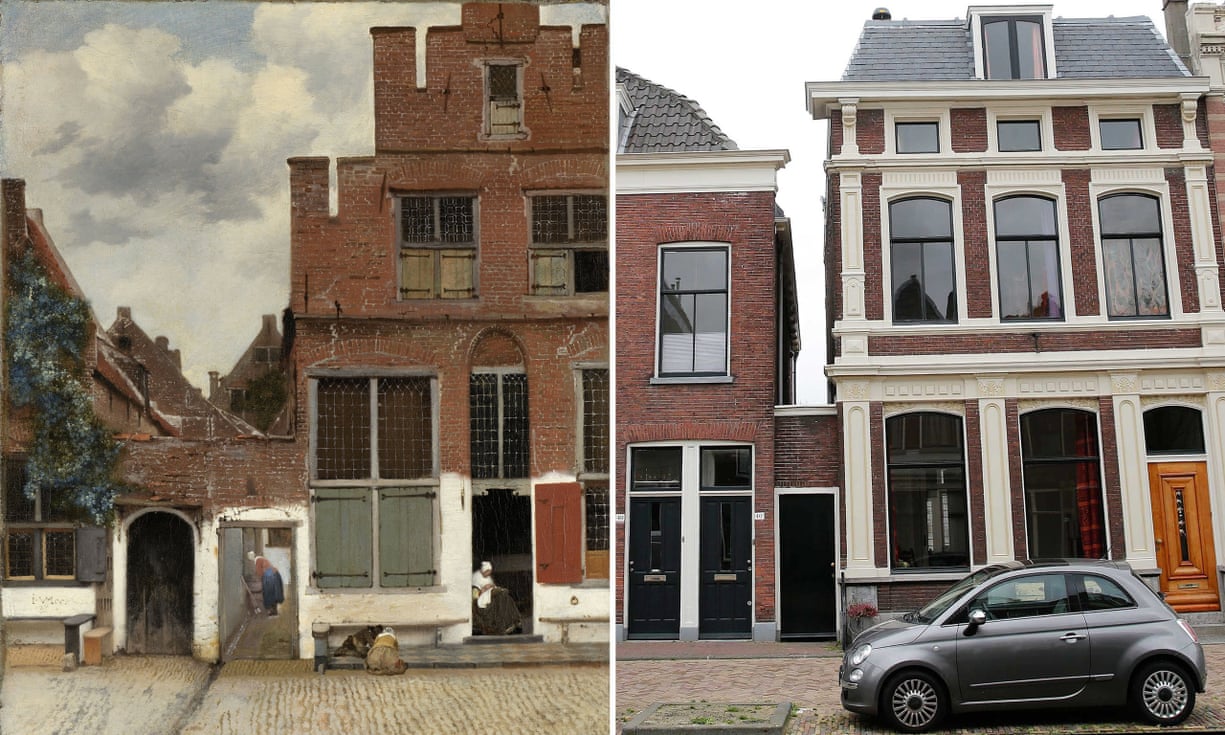
Back in the 1650s Johannes Vermeer (he of camera obscura infamy) painted a rather straightforward, but beautifully detailed, streetscape from his home town of Delft, aptly named simply "The Little Street". The picture featured the house of one of his aunts - a widowed mother of several small children who eeked out a meagre living from selling tripe (the little alley to its left was still called Tripe Alley by locals up to the 20th century). It is possible that Vermeer's motive was in some way to contribute to the lady's fortunes from the sale of the painting, though why this would entail having to paint her humble abode is something about which we can only conjecture. It may be that he was just interested in the composition itself and kept the readies for himself. He was after all by all accounts a cute and parsimonious businessman as well as an indisputably great artist. On the other hand we know his mother lived nearby and that he would have grown up in both houses so there was also the possiblilty of a strong sentimental attraction for the dwelling on his part too. However what is certain is that it is actually only from a few short days ago that we know it was his aunt's house at all. And here's why.
In 1654 Delft suffered a devastating explosion caused when 30 tonnes of gunpowder stored locally was inadvertently ignited by a careless watchman. The damage was such that hardly any buildings were left unscathed and a huge proportion of them were blown to pieces. A fellow artist, Egbert van der Poel, painted Delft in the aftermath of the disaster and one can almost safely assume from this evidence that this was when Vermeer's aunt's house, at least as represented in his painting, also disappeared from the streetscape, and - it was assumed - probably even from the records.

We know that the streetscape apparently disappeared early in the life of the painting as one of the original owners of Vermeer's work (it is now owned by the Rijksmuseum in Amsterdam) was the first to attempt to locate the scene and failed. Since then numerous attempts by owners and researchers have been made to resolve the mystery, a mystery made all the more challenging by the fact that Vermeer, of all contemporary artists of his period, could be pretty safely relied upon to reproduce as faithfully as possible the physical subject as presented to his view.
Just yesterday it was announced publicly that the mystery may now have finally been resolved for once and for all. Frans Grijzenhout, professor of art history at Amsterdam University, found in his research a document from the 1660s, a mere decade after both the painting and the disaster, in which were listed all the taxable dwellings in the city along with their measurements and addresses, the purpose of which was to regulate the raising of taxes to finance the cost of vast new dredging works about to be inaugurated around the city (partly to reclaim land so that the re-emergent town was not so confined and therefore less likely to be flattened again by a careless watchman).
By estimating dimensions, especially of the alleyway, relative to those around them as portrayed in the painting, and then as listed in the very detailed "De legger van het diepen der wateren binnen de stad Delft" record from 1667, Grijzenhout found that there was in fact only one situation on any Delft street where the two coincided - the north side of Vlamingstraat, a street that formed an embankment on one of Delft's oldest canals. The records revealed the owner to be the artist's aunt, and so the 350 year old puzzle finally all fell into place.
So chuffed are the people at the Rijksmuseum that they will now mount a special exhibition highlighting the whole shebang, and they have promised that of course it will be transferred in time to the haystack where the needle originally had gone so tantalisingly missing, Delft.

A current google street view of Vermeer's aunt's house shows - rather fittingly given her economic straits - that the present building, erected in the 1800s, is now adjacent to the home to The Salvation Army (Leger des Heils in Dutch).
